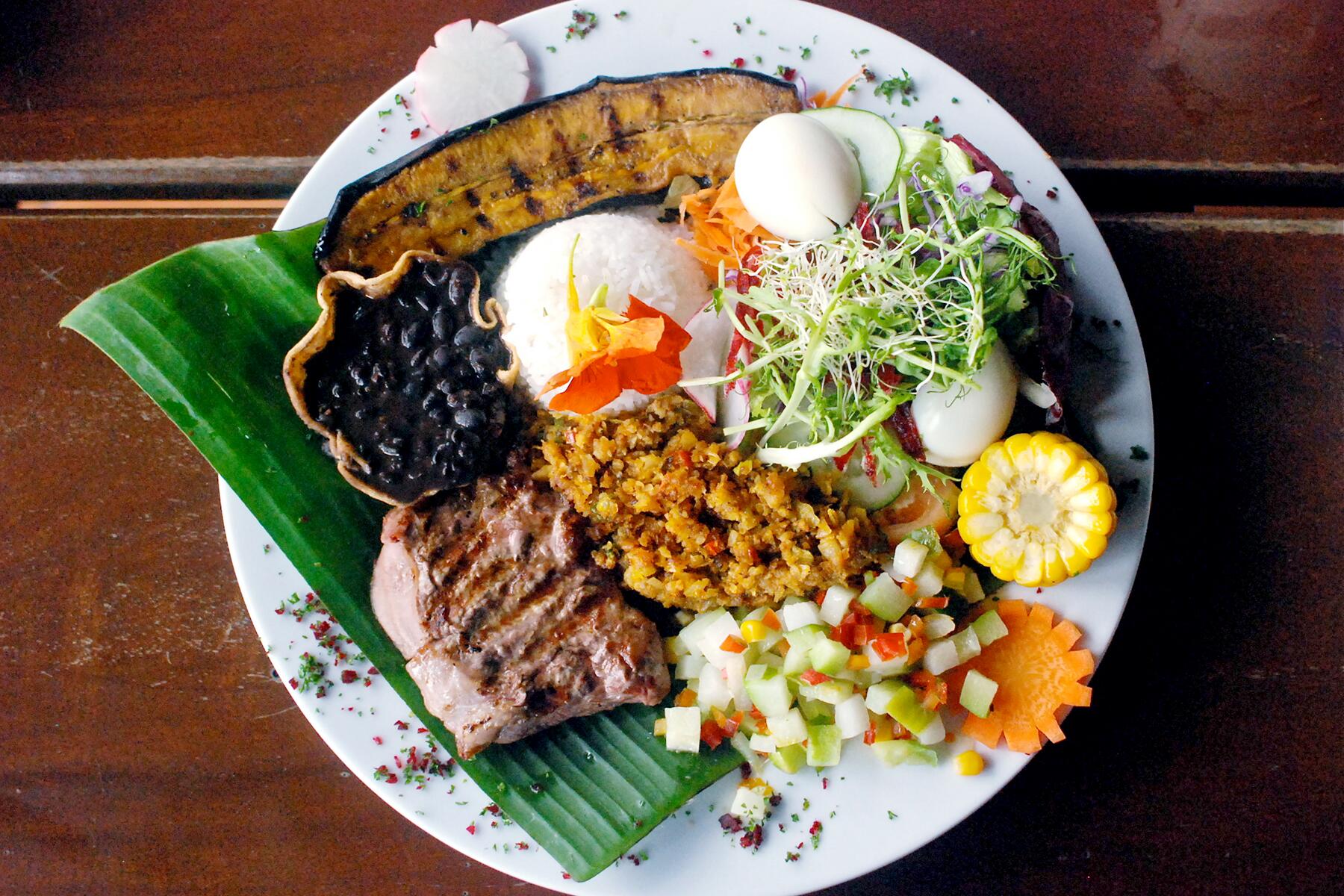All food south of the border is not the same.
Don’t come to Costa Rica expecting to eat tacos and enchiladas, unless you dine at a Mexican restaurant here. Costa Rican cuisine is completely different, rich in its own right, and at its most basic, hearty, filling, and usually not spicy. Here are 12 Tico-approved dishes to get your Costa Rica adventure started off right.
Top Picks for You
Gallo Pinto
Costa Rica’s signature dish, which means “spotted rooster,” is so typical of the country there’s a saying: “Más tico que el gallo pinto.” It means “More Costa Rican than gallo pinto.” You’ll find the mix of rice, black beans, chopped bell peppers, and cilantro all over the country—even McDonald’s offers McPinto on its breakfast menu—and there are as many gallo pinto recipes as there are households. Dress it up with a dollop of sour cream the way folks here do and heap it onto a tortilla.
Tres Leches
This sweet, decadent sponge cake gets soaked in a sauce made with three different types of milk: condensed, evaporated, and sweet cream. Though it sounds like the cake would be soggy, successful takes are actually quite light. Some variations substitute whole milk for the cream to cut the sweetness.
Recommended Fodor’s Video
Arroz con Pollo
Comfort food at its finest, this chicken-and-rice dish is a staple in any Tico home, although you’ll see Latin America–wide variations. Even finicky eaters enjoy the shredded chicken, with sautéed and chopped veggies like celery, corn, bell peppers, cilantro, and carrots over rice.
Casado
Fortify yourself with a midday casado at a small mom-and-pop restaurant—you’ll usually see the deal scrawled on a blackboard. “Casado” means “married,” and the plate “marries” meat, vegetables, rice, and plantains. Plan on choosing one of four proteins: beef, pork, fish, or chicken.
Imperial
Far and away, the most popular locally brewed beer is this pale lager. The same brewery—jointly Costa Rican and Dutch-owned—also makes Pilsen and Bavaria (both slightly fuller in body), as well as a locally brewed Heineken. A small, but growing, industry of craft brewers has taken hold here with their own pubs in San José, Santa Ana, Lake Arenal, Monteverde, Tamarindo, and Puerto Viejo de Talamanca.
Salsa Lizano
It’s the quintessential Costa Rican condiment, and no self-respecting home or restaurant does without it. It started as a response to Lea & Perrins 1920 introduction of Worcestershire sauce to Costa Rica. “I can do better,” insisted a local man, and Salsa Lizano was born. Often likened to a tangier version of Worcestershire, it goes well on gallo pinto and arroz con pollo; back home, try it on steaks, burgers, or scrambled eggs.
Frutas
Sure, you know bananas and pineapples, two of Costa Rica’s top agricultural exports, as well as oranges, mangoes, and papayas. But you’ll also encounter exotic-sounding fruits at farmers’ markets (ferias) like the egg-shaped maracuyá (similar to passion fruit) and guanábana (soursop), which can weigh in at up to five pounds. The sweet, nutritious carambola (star fruit) makes a thirst-quenching treat on a hot day.
Café
Café is coffee, the country’s signature product. If nearby Honduras was the original “Banana Republic,” 19th-century Costa Rica could be called a Coffee Republic. Here’s the kicker: True to the realities of developing-country economics, quality coffee goes for export, leaving an inferior bean behind. Your best bet here for a good cup of the stuff is an upscale restaurant that caters to foreigners.
Ensalada de Palmito
Costa Rica is the world’s top exporter—16 million pounds annually—of heart of palm. The cylindrical, ivory-colored vegetable comes from the inner stem of coconut and peach palms; you’ll equate palmito’s flavor with artichokes. A particularly Costa Rican treat, especially popular around Easter, is palmito chopped into a salad along with crunchier vegetables and dressed with mayonnaise.
Sopa Negra
This filling black bean soup with a poached egg is thick enough to spoon onto a tortilla. Most cooks garnish with cheese, sour cream, cilantro, chopped bell pepper, or slices of the egg to add some visual pizzazz to an otherwise unattractive-looking dish—though there’s nothing ho-hum about the flavor.
Rondón
Afro-Caribbean immigrants brought this hearty soup to the Caribbean coast. Back in Jamaica, they called it “run down”—made with whatever ingredients the cook could run down. Somewhere between English and Spanish, the name here became rondón. Expect fresh fish, lobster, or crab, with plantains, cassava, and yams. Ají chombo (Panamanian pepper) adds a bit of fire. Rondón takes hours to prepare, so Caribbean dining spots don’t make it every day.
Rice and Beans
This is not the gallo pinto you’ve seen everywhere else in Costa Rica. It’s a Caribbean dish whose name is always rendered in English. Rice and beans (red or black) are steeped in fresh coconut milk. It’s always a side dish, often served with a whole fried fish and patacones (fried plantains).




